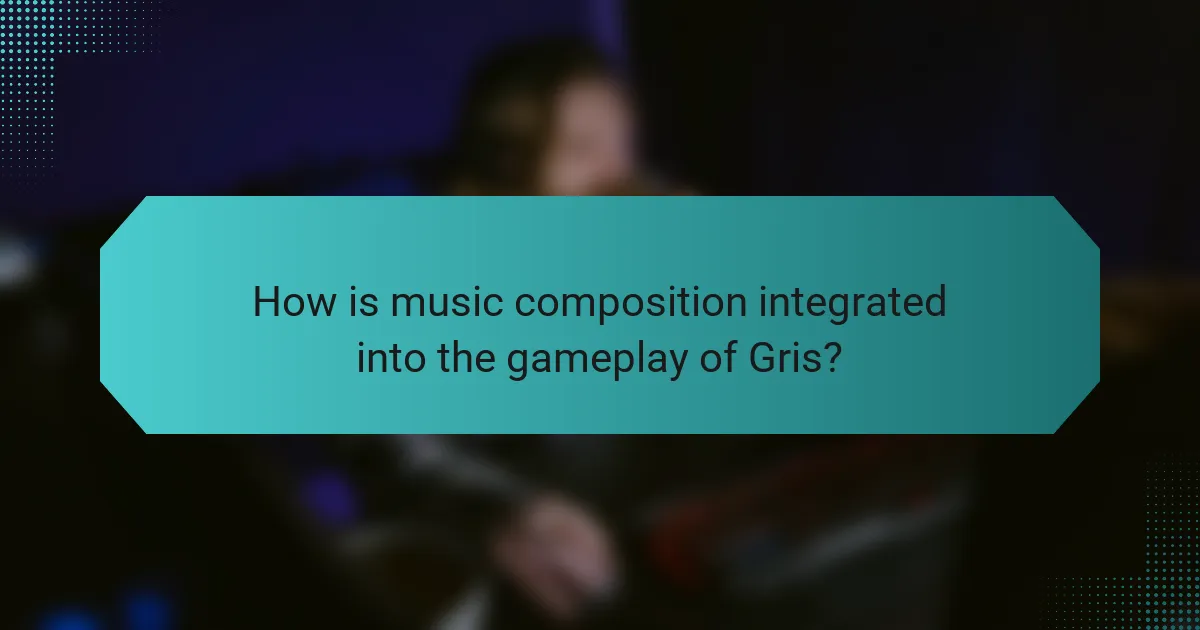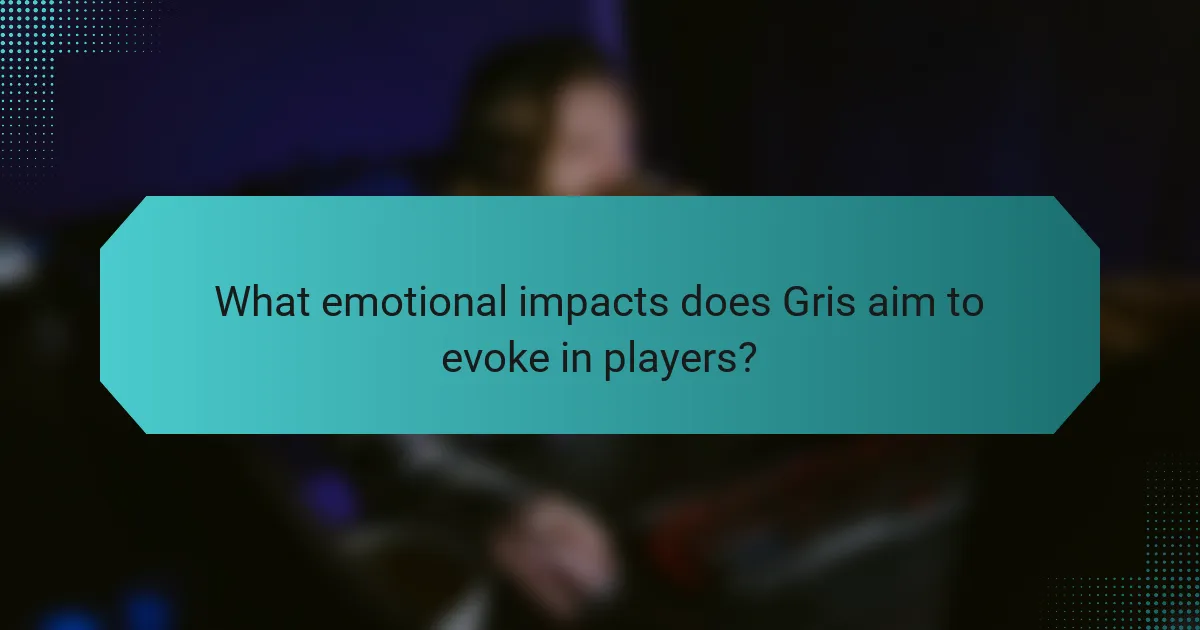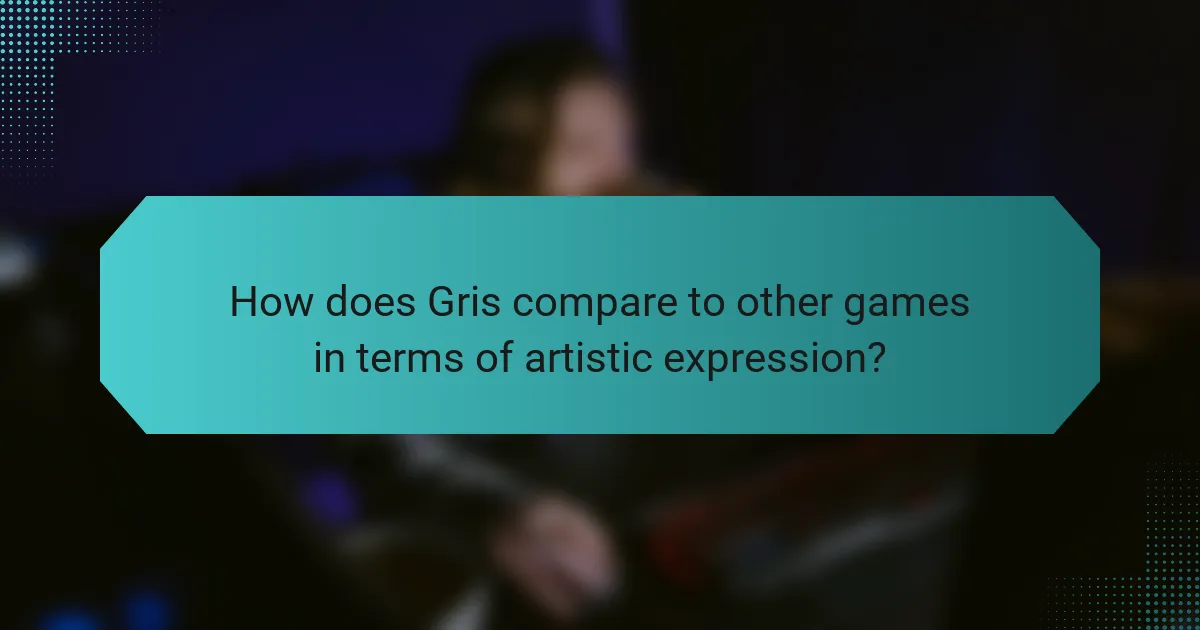Gris captivates players with its unique blend of visual storytelling and music composition, creating a profound emotional impact. The game’s evolving colour palette and symbolic imagery enhance the narrative. Music complements the visuals, reflecting the protagonist’s journey through grief. Together, these elements foster a deeply introspective experience, setting Gris apart in the gaming landscape.

What are the key elements of visual storytelling in Gris?
Gris employs key elements of visual storytelling through its use of colour, symbolism, and animation. The game utilises a unique colour palette that evolves with the narrative, reflecting the protagonist’s emotional journey. Symbolic imagery enhances the storytelling, allowing players to interpret deeper meanings without explicit dialogue. Fluid animations create a seamless connection between gameplay and emotional impact, immersing players in the experience. Together, these elements craft a powerful narrative that resonates on an emotional level, making Gris a standout example of visual storytelling in gaming.
How does colour symbolism enhance narrative depth?
Colour symbolism enhances narrative depth by conveying emotions and themes visually. In “Gris,” colours express character development and plot progression. Each hue signifies specific feelings, enriching the viewer’s experience. For example, warm colours evoke warmth and comfort, while cool colours suggest melancholy. This visual storytelling technique deepens emotional impact, allowing audiences to connect with the narrative on a profound level. By using colour strategically, “Gris” elevates its story, making themes more resonant and memorable.
What role do character designs play in emotional engagement?
Character designs significantly enhance emotional engagement by visually representing characters’ personalities and experiences. In “Gris,” the character’s design evolves, reflecting emotional states and narrative progression. This visual storytelling fosters a deeper connection with players, allowing them to empathise with the character’s journey. The unique attribute of fluid animation further amplifies emotional responses, as movements convey feelings without words. Overall, character design in “Gris” is integral to its emotional impact, creating a rich, immersive experience.
Which visual techniques create immersive experiences?
Visual techniques that create immersive experiences include vibrant colour palettes, dynamic animations, and evocative soundscapes. These elements enhance emotional engagement and storytelling depth. For instance, Gris utilises a unique art style that combines watercolour aesthetics with fluid transitions, fostering a profound connection with players. The integration of music composition further amplifies emotional impact, guiding players through the narrative journey.

How is music composition integrated into the gameplay of Gris?
Music composition is integral to Gris, enhancing emotional depth and gameplay experience. The score evolves with the narrative, reflecting the protagonist’s journey through stages of grief. Each musical piece corresponds to specific visuals and gameplay mechanics, creating a cohesive emotional atmosphere. The unique blend of orchestral and electronic elements enriches the storytelling, making music a core component of player engagement.
What types of musical styles are featured throughout the game?
“Gris” features a diverse range of musical styles that enhance its emotional narrative. The game incorporates orchestral compositions, minimalist piano melodies, and ambient soundscapes. Each style corresponds to the game’s visual themes and emotional arcs, creating a cohesive experience. The unique blend of these musical elements deepens player engagement and reflects the protagonist’s journey.
How does the soundtrack influence player emotions and actions?
The soundtrack significantly influences player emotions and actions by creating an immersive atmosphere. In “Gris,” music enhances the visual storytelling, evoking feelings of joy, sadness, and introspection. This emotional engagement drives players to connect deeply with the narrative, influencing their choices and reactions throughout gameplay. The unique composition adapts to player actions, reinforcing feelings and guiding the overall experience. As a result, the synergy between music and visuals amplifies emotional impact, making the gameplay memorable.
In what ways do sound effects contribute to the overall atmosphere?
Sound effects significantly enhance the atmosphere in “Gris” by immersing players in its emotional landscape. They create auditory cues that complement visual storytelling, enriching the narrative experience. For instance, subtle sounds during exploration evoke feelings of tranquility, while impactful effects during key moments amplify emotional responses. This synergy between sound and visuals fosters a deeper connection to the game’s themes, making the overall experience more engaging and memorable.

What emotional impacts does Gris aim to evoke in players?
Gris aims to evoke a profound sense of introspection and emotional resonance in players. The game utilises visual storytelling and music composition to guide players through themes of loss, hope, and self-discovery. Each chapter’s distinct colour palette and soundscape enhance emotional engagement, allowing players to connect deeply with the protagonist’s journey. The unique attribute of Gris is its ability to convey complex emotions without dialogue, relying solely on art and music to communicate feelings. This approach fosters a personal and reflective experience, making it memorable and impactful.
How do themes of loss and recovery manifest in gameplay?
Themes of loss and recovery in gameplay are central to Gris’s narrative. The game visually represents emotional states through its art style, transitioning from muted tones to vibrant colours as the character progresses. This journey symbolizes recovery from grief, illustrating how loss can lead to personal growth. The music composition enhances this experience, with melodies that evoke feelings of sadness and hope. Each gameplay segment reflects stages of emotional healing, allowing players to connect deeply with the protagonist’s journey.
What psychological effects can arise from the game’s artistic choices?
The artistic choices in “Gris” evoke profound psychological effects, including emotional resonance and introspection. The game’s colour palette and visual transitions symbolize stages of grief, leading players through a journey of loss and healing. The integration of music enhances this emotional impact, creating an immersive experience that fosters empathy and reflection. As a result, players often report feelings of catharsis and connection to their own experiences.
Which moments in the game are most impactful for emotional resonance?
Key moments in “Gris” that evoke emotional resonance include the protagonist’s transformative experiences, the interplay of colour and music, and the climactic encounters with loss and hope. These moments are designed to connect deeply with players, enhancing the narrative through visual storytelling and composition. The unique attribute of “Gris” lies in its ability to convey complex emotions without dialogue, relying on artistic elements to create a profound impact. Each significant scene, such as the transition from despair to acceptance, resonates powerfully, reinforcing the game’s emotional core.

How does Gris compare to other games in terms of artistic expression?
Gris excels in artistic expression compared to other games through its unique visual storytelling, music composition, and emotional impact. The game’s hand-painted aesthetics create a vivid, immersive world that enhances narrative depth. Unlike many titles, Gris employs a minimalist approach to gameplay, focusing on emotional experiences over traditional mechanics. The music, composed by Berlinist, complements the visuals, further amplifying the emotional resonance. This combination of art and sound sets Gris apart, creating a distinctive atmosphere that engages players on a profound level.
What unique storytelling methods set Gris apart from similar titles?
Gris employs unique storytelling methods through its stunning visual art, immersive music, and profound emotional resonance. The game’s art style uses a watercolour aesthetic, offering a fluid and dreamlike experience that enhances narrative depth. The musical composition complements gameplay, evolving with the protagonist’s emotional journey, creating a cohesive atmosphere. Gris’s ability to convey complex themes of grief and recovery without dialogue sets it apart, allowing players to interpret the story personally. This emotional impact fosters a deep connection, making the experience memorable and distinct from similar titles.
How do player experiences differ between Gris and traditional narrative games?
Player experiences in Gris differ from traditional narrative games through immersive visual storytelling, unique music composition, and profound emotional impact. Gris emphasizes aesthetics over dialogue, creating a wordless journey that evokes feelings through art and sound. Traditional narrative games often rely on extensive text and character interactions, which can dilute emotional resonance. The fluid animation style in Gris enhances player engagement, while traditional games may prioritize gameplay mechanics over artistic expression. This distinction leads to a more personal connection with the narrative in Gris, as players interpret emotions through visual cues rather than explicit storytelling.

What are the common challenges players face while experiencing Gris?
Players commonly face challenges in Gris related to its emotional depth, gameplay mechanics, and visual storytelling. The abstract narrative can lead to confusion about objectives. Players may struggle with the platforming elements, which require precise timing and coordination. Additionally, the game’s pacing can be slow, potentially causing frustration for those seeking immediate action. The emotional weight of the story may also evoke strong feelings, making it difficult for some players to engage fully.
How can players overcome emotional barriers during gameplay?
Players can overcome emotional barriers during gameplay by engaging with the narrative and music of Gris. The game’s visual storytelling creates an immersive experience that resonates emotionally. Players can reflect on their feelings, using the game’s art and sound to process emotions. Practicing mindfulness during gameplay helps maintain focus and reduce anxiety. Additionally, sharing experiences with other players fosters a supportive community, enhancing emotional resilience. Embracing the game’s unique attributes, such as its artistic style and emotional depth, allows players to connect more profoundly, facilitating personal growth.
What strategies can enhance the overall experience of Gris?
To enhance the overall experience of Gris, focus on its visual storytelling, music composition, and emotional impact.
Engaging with the game’s art style deepens immersion. The unique watercolour visuals create a dreamlike atmosphere, enhancing emotional resonance. Music composition plays a crucial role, as the score evolves with gameplay, reflecting the character’s journey. Players should take time to explore each environment, as the rare details enrich the narrative.
Additionally, allowing moments of silence can amplify emotional impact. These pauses give players space to reflect on the story and visuals, fostering a deeper connection with the experience.
Which aspects of the game may lead to misunderstandings among players?
Players may misunderstand Gris due to its abstract narrative, visual symbolism, and emotional cues. The game relies heavily on interpretation, which can lead to varied personal experiences. Additionally, the lack of explicit instructions can create confusion regarding mechanics and objectives. Players may also misinterpret the emotional tone conveyed through music and visuals, affecting their overall engagement.
What best practices can enhance emotional engagement in narrative-driven games?
To enhance emotional engagement in narrative-driven games like Gris, focus on immersive visual storytelling and evocative music composition. These elements create a profound emotional impact by connecting players to the game’s themes and characters.
Visual storytelling in Gris employs vibrant colours and fluid animations to convey emotions without words. The art style complements the narrative, allowing players to experience the protagonist’s journey on a deeper level.
Music composition plays a crucial role in setting the tone and atmosphere. The score evolves alongside the gameplay, enhancing emotional moments and guiding players through the narrative arc.
Incorporating player choices can further deepen engagement. Allowing players to influence the story fosters a personal connection, making the emotional experience more impactful.